A perfect cold process soap batch of 3-5 pounds yields 12-20 bars, offering ideal balance between experimentation and efficiency. Use a reliable formula of 50% olive oil, 31% coconut oil, 6% castor oil, and 13% butter, with proper lye calculations (6-10 ounces) and distilled water (12-20 ounces). You'll need digital scales, stick blender, thermometer, and safety gear. Maintain temperatures within 10°F of each other and cure for 4-6 weeks. The details below will transform your soapmaking results dramatically.
Perfect Cold Process Soap Batch: 3-5 Pound Batches
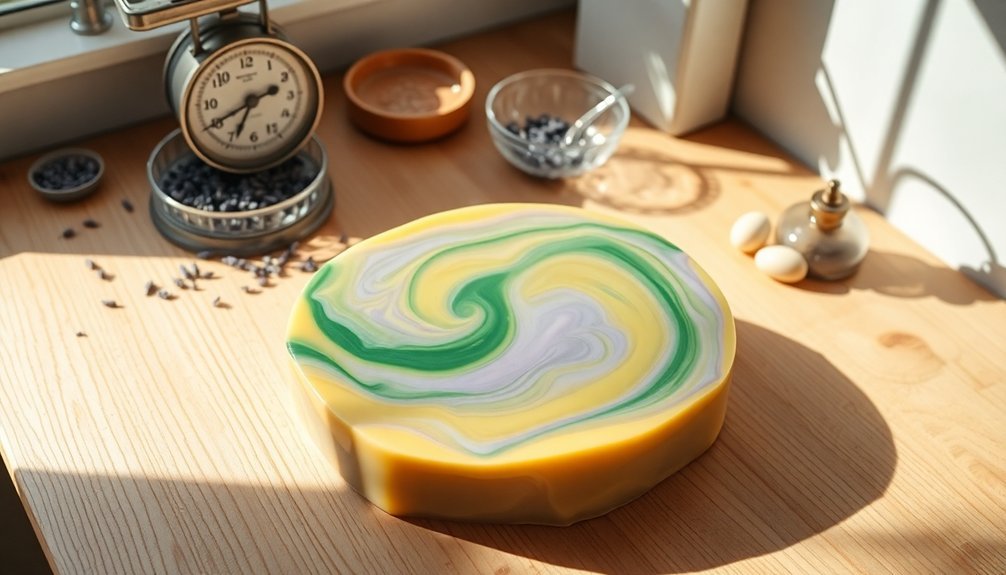
While many soap recipes vary widely, creating a perfect 3-5 pound cold process batch requires precise measurements and proper oil balance.
Precision and balance transform simple ingredients into extraordinary handcrafted soap—a science as much as an art.
For this size batch, use 48-80 ounces of oil total, with 12-20 ounces of distilled water and 6-10 ounces of lye.
Maintain a 50% olive/rice bran oil, 31% coconut oil, 6% castor oil, and 13% butter ratio for balanced texture and lather.
When scaling your batch of soap from larger recipes, remember to divide the lye and water proportionally to your oil weight.
During cold process soap making, use a stick blender to achieve medium trace by pulsing for 30 seconds to a few minutes.
After pouring into molds, allow your soap to cure 4-6 weeks for peak hardness.
Benefits of Medium-Sized Soap Batches
You'll find that medium-sized batches (3-5 pounds) strike the perfect balance between experimentation and practicality, allowing you to test new formulations without wasting precious ingredients.
Your soap making journey becomes more manageable as these batches yield 12-20 bars—enough to use, gift, and evaluate while controlling quality throughout the saponification process.
These thoughtfully sized batches enable you to document your process effectively, making adjustments for future batches while minimizing waste and maximizing your learning curve.
Size Matters
Many soap makers discover that medium-sized batches strike the perfect balance between experimentation and practicality. When you're making soap, working with 3-5 pounds of oils gives you enough product to test thoroughly without overwhelming your resources.
| Batch Size | Benefits | Yield | Ideal For |
|---|---|---|---|
| Test (4 oz) | Quick learning | 1-2 bars | Beginners |
| Small (1-2 lbs) | Low waste | 4-8 bars | New recipes |
| Medium (3-5 lbs) | Balanced approach | 12-20 bars | Regular makers |
| Large (10+ lbs) | Production efficiency | 40+ bars | Businesses |
Medium-sized soap making batches allow you to monitor the saponification process closely while still producing enough bars to test different scents and additives. You'll find it easier to calculate adjustments using lye calculators, maintaining quality control without committing to commercial quantities.
Optimal Resource Efficiency
Medium-sized soap batches offer exceptional resource efficiency that experienced crafters consistently value.
When you work with 3-5 pound batches in cold process soapmaking, you'll create 12-20 bars per session—enough to stock your supply without overwhelming storage space or ingredients.
These medium-sized batches strike the perfect balance for testing new formulations without excessive waste.
You'll appreciate how efficiently you can measure ingredients using standard 1/2 pound or 1/4 pound oil portions, making calculations straightforward and precise.
The recommended 2:1 water-to-lye ratio guarantees ideal saponification while conserving materials.
You'll maximize your creative potential by experimenting with various oils and additives without committing large quantities of precious resources.
This ideal resource efficiency allows you to perfect your craft while maintaining cost-effectiveness.
Essential Equipment for 3-5 Pound Batches
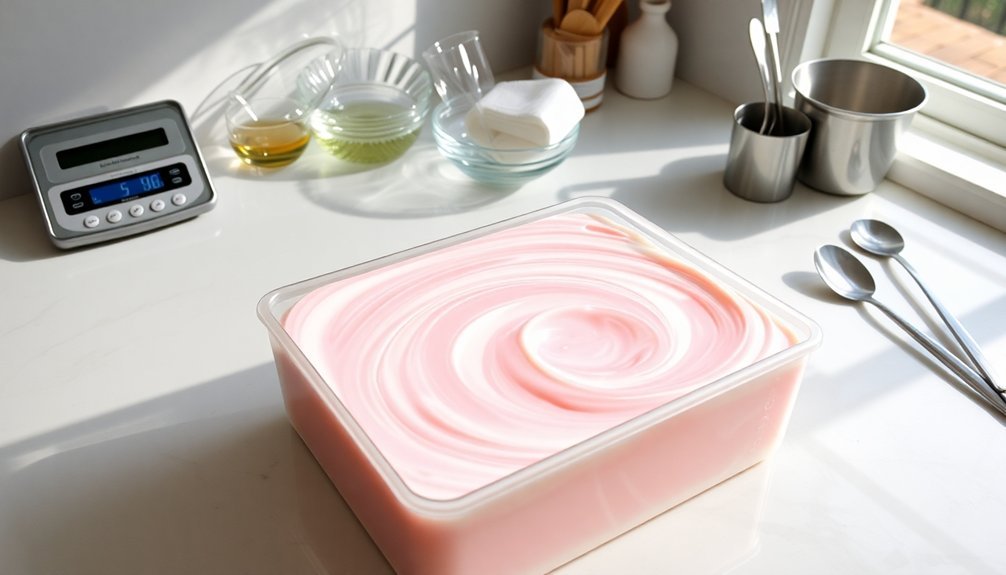
Equipping yourself for 3-5 pound soap batches requires precision tools, starting with a reliable digital scale that accurately measures both small and large quantities of ingredients.
You'll need thorough safety gear including chemical-resistant gloves, protective goggles, and long-sleeved clothing to shield your skin from potential lye burns during the soap-making process.
A dedicated lye calculator is also essential for determining the exact measurements needed for your specific oil combinations, ensuring your finished soap achieves the perfect balance.
Scales and Measuring Tools
Four essential measuring tools stand between success and disaster when making cold process soap.
A digital kitchen scale with at least 5 kg (11 lbs) capacity is non-negotiable for accurately measuring your oils, lye, and water for 3-5 pound batches.
You'll need measuring spoons and cups for small additives like colorants and essential oils to guarantee your soap has the perfect scent and appearance.
A reliable thermometer is vital to monitor both your lye solution and oils, which should be within 10°F of each other before combining.
Finally, invest in a stick blender for efficient mixing to reach trace quickly, giving you better control over consistency.
Don't forget a dedicated heat-resistant container specifically for measuring lye to prevent unwanted chemical reactions.
Safety Gear Essentials
Safety must take priority whenever you're working with lye, even more so than precise measurements. Before mixing your first 3-5 pound batch, make certain you've assembled all necessary protective equipment to prevent potential injuries during the soap-making process.
- Safety goggles – Protect your eyes from potential splashes of caustic lye solution that can cause serious damage.
- Chemical-resistant gloves – Shield your hands from burns that can occur with even brief lye contact.
- Long sleeves and pants – Cover exposed skin completely to minimize risk during handling of all ingredients.
- Well-ventilated area – Work in a space with good airflow to avoid inhaling potentially harmful fumes generated when lye dissolves in water.
Never compromise on these safety essentials, regardless of your experience level.
Scaling Recipes to Perfect Batch Size
When you're ready to create the ideal cold process soap batch, scaling your recipe to achieve the perfect 3-5 pound size becomes crucial for consistent results.
Simply divide or multiply your oil weights while maintaining the same percentage ratios in your formulation.
Maintain consistency by adjusting quantities, not proportions—it's the secret to successful soap scaling.
For a 3-pound batch of cold process soap, you'll need approximately 39 grams of lye and 77 grams of distilled water for your lye solution.
Scaling up to 5 pounds requires about 64 grams of lye and 129 grams of water.
Always verify your calculations using reliable soap calculators like Soapee or Soapmakers Friend to guarantee safety and quality.
Keep detailed records of your adjustments, including superfat levels and any ratio changes, for future reference and consistency across batches.
Lye Calculations for Medium Batches
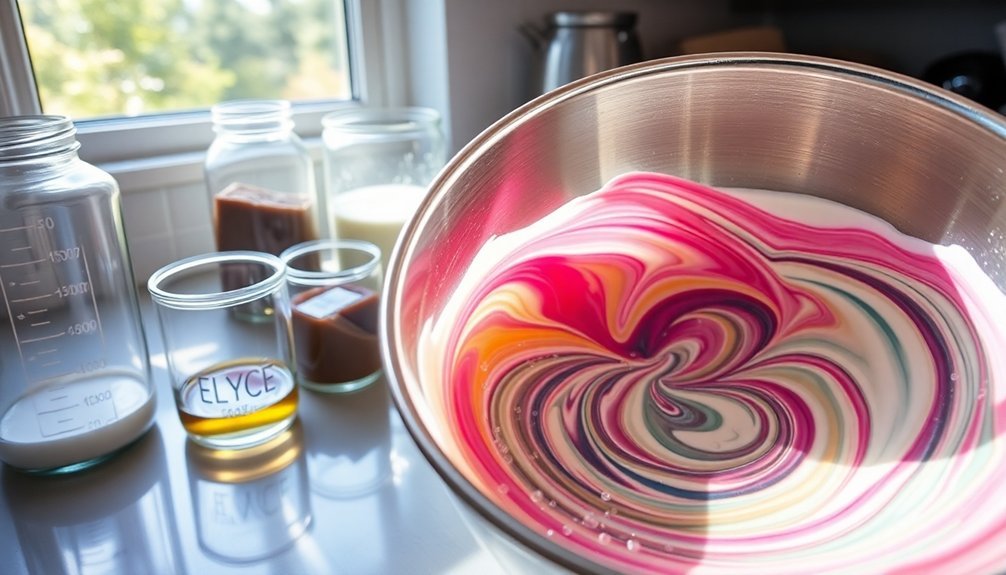
Accurate lye calculations form the foundation of any successful medium-sized soap batch.
When making cold process soap in the 3-5 pound range, you'll need to carefully measure your lye and water amounts based on your oils.
- 3-pound batch: Use approximately 0.32 ounces (9 grams) of lye and 0.64 ounces (18 grams) of distilled water per pound of oils
- 4-pound batch: Increase to 0.43 ounces (12 grams) of lye and 0.86 ounces (24 grams) of distilled water per pound of oils
- 5-pound batch: Scale up to 0.55 ounces (16 grams) of lye and 1.1 ounces (31 grams) of distilled water per pound of oils
- Maintain a 2:1 ratio: For every calculated ounce of lye, use two ounces of distilled water
Always run your specific oil combination through a soap calculator for precise measurements.
Safety and accuracy can't be compromised.
Oil Selection and Proportions
Choosing the right oils in proper proportions serves as the cornerstone of a successful cold process soap batch. For 3-5 pound batches, you'll need between 48-80 ounces of oils total, depending on your desired batch size.
The foundation of exceptional cold process soap lies in selecting quality oils in balanced proportions for your desired batch size.
A balanced oil selection creates superior cold process soap. Consider a proven formula of 50% olive oil for conditioning, 31% coconut oil for cleansing and lather, 6% castor oil for bubble stability, and 13% shea or cocoa butter for hardness and luxury.
Remember that each oil contributes unique properties: coconut provides cleansing power while olive delivers creaminess. You'll want to balance these characteristics in your formulation for ideal results.
Always verify your oil proportions through a lye calculator to confirm correct water and lye amounts for safe saponification.
Selecting Appropriate Molds
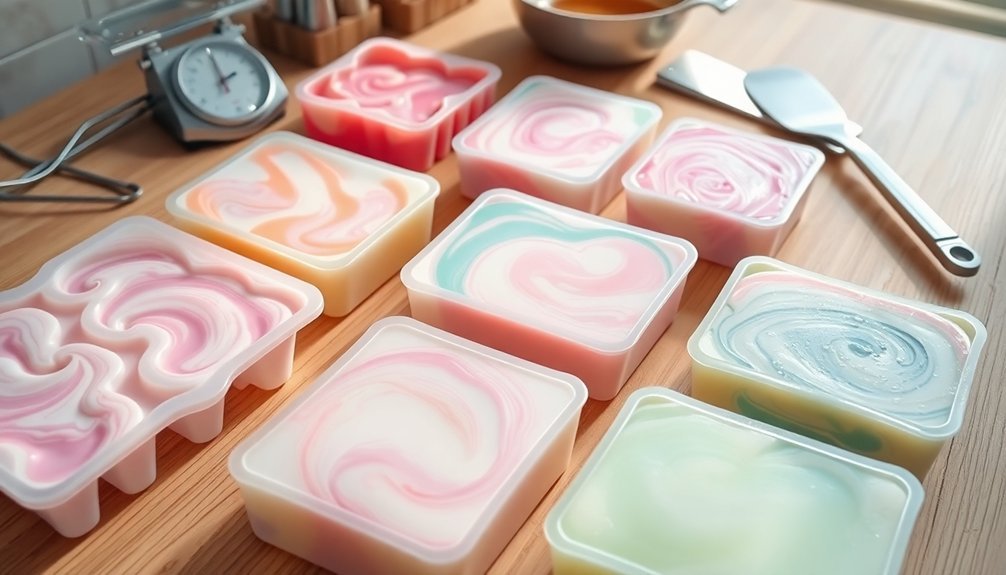
When making cold process soap, you'll need a mold that provides 12-20 ounces of capacity per pound of soap to accommodate expansion during saponification.
For your batch size of 3-5 pounds, consider whether you want flexible silicone molds that make unmolding easier or wooden molds lined with freezer paper or parchment to prevent sticking.
Your choice of mold will determine the final shape and size of your bars, with standard loaf molds yielding 4-6 ounce bars and smaller cavity molds producing guest-sized soaps.
Mold Size Considerations
The success of your 3-5 pound cold process soap batch largely depends on selecting appropriately sized molds. When working with this volume, you'll need a mold with 36-100 ounces total capacity, allowing approximately 12-20 ounces per pound of soap.
Wooden loaf molds work exceptionally well for 3-5 pound batches, typically measuring about 10 inches long by 4 inches wide. Their sturdy construction guarantees your soap cures evenly and maintains its shape.
- Choose molds with flat bottoms and straight sides for easier cutting and professional-looking bars.
- Consider silicone molds for smaller batches due to their flexibility when unmolding.
- Look for molds that accommodate 12-20 ounces per pound of soap.
- Use dividers in larger molds to create consistent individual bars.
Liner Material Options
Proper liner selection can make or break your soap unmolding experience, especially when working with 3-5 pound batches.
Silicone molds offer the most convenience as they don't require any additional mold liners due to their flexible, non-stick nature.
For rigid molds, freezer paper is your best friend—just guarantee the shiny side faces inward toward your soap. This creates a moisture barrier that prevents sticking and makes removal effortless.
Wax paper can also work effectively in a pinch.
If you're using cardboard boxes for larger batches, line them thoroughly with freezer paper for structural integrity and easy cleanup.
Avoid plastic wrap entirely, as it can melt during saponification and stick permanently to your soap, ruining your creation's appearance.
Colorant and Additive Measurements
Achieving the perfect color balance in your cold process soap requires precise measurement of colorants and additives. For standard 3-5 pound batches, use approximately 1 teaspoon of colorant per pound of oils, adjusting based on desired intensity.
Color perfection in cold process soap demands exact measurements—typically 1 teaspoon of colorant per pound of oils in standard batches.
Always pre-mix your colorants with a small amount of oil or water to prevent clumping and guarantee even distribution throughout your soap.
- Use 1 tablespoon of clay or botanical additives per pound of oils for enhanced texture and color.
- For small test batches (4 oz), start with just 1/4 teaspoon of colorant.
- Measure essential oils at 0.5-1 ounce per pound of oils for proper fragrance strength.
- Pre-disperse all colorants in a carrier oil before adding to your soap batch for streak-free results.
Essential Oil and Fragrance Ratios
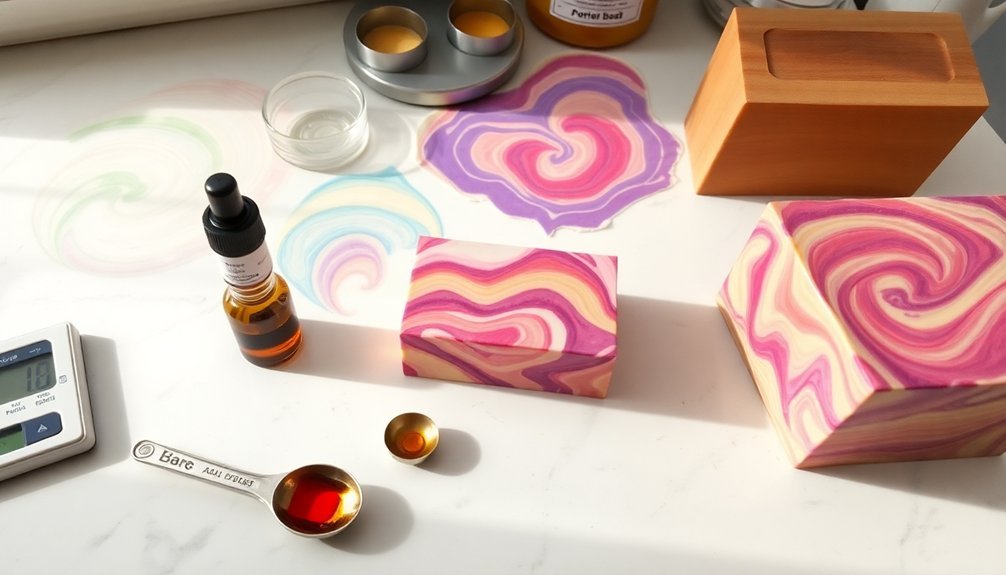
Three critical factors determine successful scent incorporation in cold process soap: oil type, quantity, and blending technique. When working with 3-5 pound batches, you'll need to calculate your essential oil amounts carefully to achieve lasting fragrance without wasting expensive materials.
| Oil Type | Usage Rate | Best For | Notes |
|---|---|---|---|
| Light Essential Oils | 0.5 oz/lb of base oils | Delicate scents | Citrus, herbs |
| Strong Essential Oils | 0.7-1 oz/lb of base oils | Bold fragrances | Spice, wood |
| Fragrance Oils | 0.5-2 oz/lb of base oils | Consistent scents | Follow supplier guidelines |
| Oil Blends | 5-7% of total batch weight | Complex profiles | Document ratios |
For test batches, use 1 teaspoon per 8 ounces of oils. Recording your results helps guarantee consistency across future batches and improves scent retention.
Temperature Management for Larger Volumes
When scaling up to larger soap batches, temperature control becomes increasingly essential as heat dynamics change dramatically with volume.
Larger quantities of oils and lye solutions retain heat longer, potentially accelerating the saponification process and affecting your final product's quality.
For successful temperature management in larger batches:
- Keep lye and oils within 10°F of each other, ideally below 130°F before combining.
- Use ice baths or pre-chilled distilled water to cool components faster.
- Document temperature readings throughout the process for future recipe refinement.
- Consider insulated molds or blanket wrapping to maintain even temperatures during the gel phase.
Remember that slight temperature variations can considerably impact your soap's texture and appearance when working with 3-5 pound batches, so consistent monitoring is key to achieving predictable results.
Pouring and Molding Techniques
The successful change from liquid soap batter to beautiful finished bars depends heavily on your pouring and molding techniques. When working with 3-5 pound batches, pour your soap batter after reaching medium trace—when drizzled batter leaves a visible trail on the surface.
Choose tall, narrow molds for larger batches as they retain heat effectively during the gel phase, enhancing your soap's appearance and texture.
After pouring, gently tap the molds on your counter to release trapped air bubbles that could mar your final bars.
To prevent soda ash formation, lightly spray the soap's surface with 99% isopropyl alcohol.
Allow your creation to rest undisturbed for 3-4 days before unmolding. This patience guarantees proper setting and makes cutting easier without crumbling.
Cutting and Curing Considerations
Although your soap may appear solid after 3-4 days in the mold, successful cutting and curing require careful technique and patience.
Wait the full recommended time before unmolding your cold process soap to prevent damage and maintain structural integrity.
- Use a sharp, straight-edge cutter for clean, professional-looking bars
- Place freshly cut bars on a curing rack with adequate spacing for maximum air circulation
- Store your soap in a cool, dry location for the full 4-6 weeks curing period
- Regularly check for moisture or ash development, rotating bars if necessary
During the curing phase, your soap will continue hardening as water evaporates and saponification completes.
This patience pays off with longer-lasting, milder bars that provide better lather and cleaning power.
Troubleshooting Medium Batch Issues
Successfully executing your soap batch is only half the journey—you'll inevitably encounter issues that require prompt attention and methodical correction.
When your medium batch isn't cooperating, first verify that your lye and water measurements are exact. Even slight discrepancies can derail saponification in 3-5 pound batches.
Watch your temperature control carefully; oils and lye solution should be within 10 degrees of each other and under 130°F. If your batch refuses to reach trace after extended mixing, you're likely facing an emulsification problem from improper lye ratios or temperature differences.
Always document any recipe modifications or additive variations.
When dealing with soap that's too soft during curing, adjust your oil formulation by increasing hard oils like palm or cocoa butter for improved firmness. These targeted corrections will help transform troublesome batches into successful soaps.
Frequently Asked Questions
What Is the Best Balanced Cold Process Soap Recipe?
You'll enjoy a well-balanced cold process soap with 30-40% olive oil, 20-30% coconut oil, and 20-30% palm oil. Use a 2:1 water-to-lye ratio and 5% superfat for moisturizing properties and good lather.
What Is the Biggest Mistake First Time Soapmakers Make?
You'll likely make the critical mistake of inaccurate measurements, especially with lye. Without precise calculations using a lye calculator, you're risking unsafe soap. Don't forget essential safety gear when handling caustic ingredients!
How Many Bars Does 1 Lb of Soap Base Make?
A pound of soap base typically makes 4-5 bars, depending on your desired size. If you're cutting standard 4-5 ounce bars, you'll get about 4 bars from one pound of base material.
What Is the Ratio for Cold Process Soap Making?
For cold process soap making, you'll typically use a 2:1 water-to-lye ratio. Your oils should include about 30-35% coconut oil, 40-50% olive oil, and 15-20% palm oil with 5% superfatting for moisturizing.
In Summary
Making 3-5 pound soap batches gives you the perfect balance between efficiency and manageability. You'll save time and supplies while still creating a reasonable quantity for gifting or selling. Remember to maintain accurate measurements, especially with lye calculations, and allow proper curing time. With practice, you'll find these medium-sized batches become your sweet spot for cold process soapmaking – not too big, not too small, but just right.

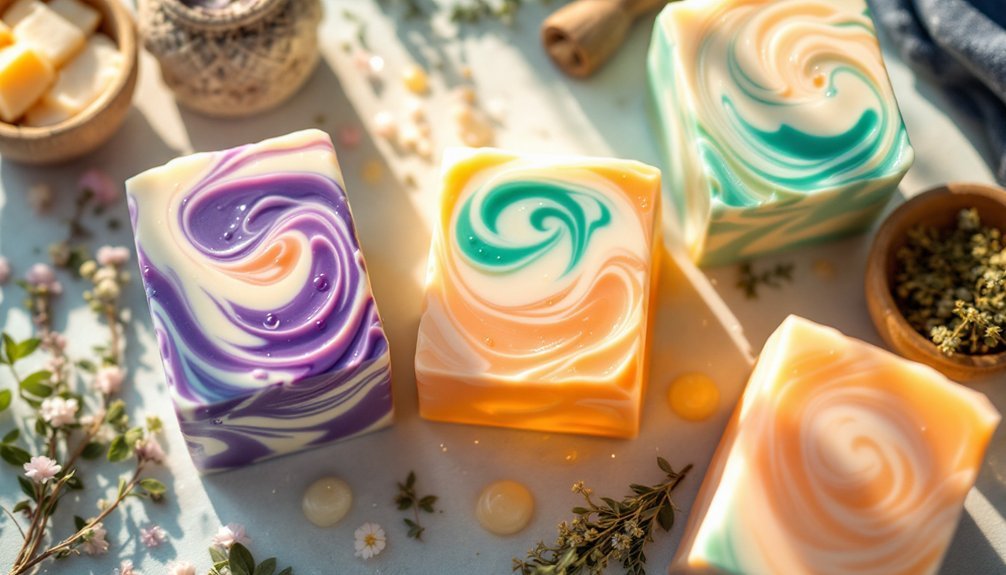



Leave a Reply